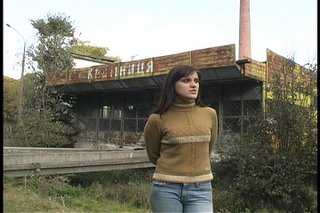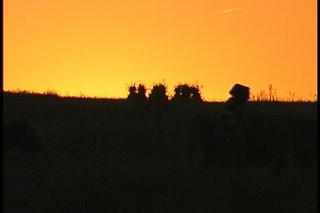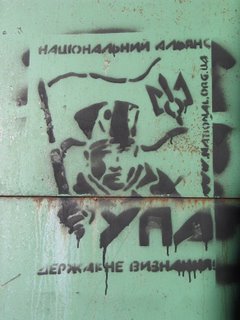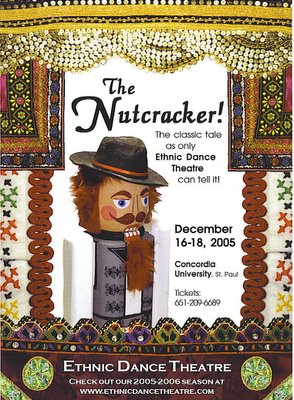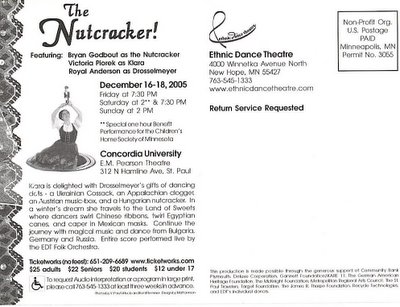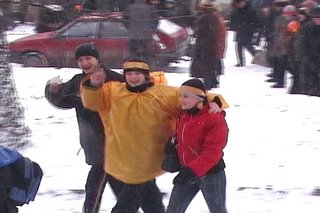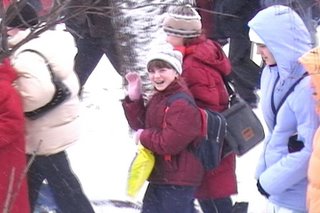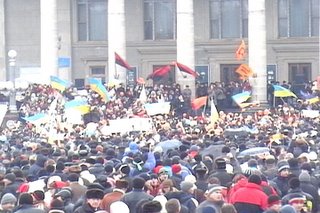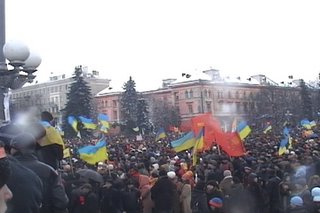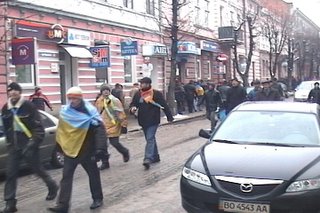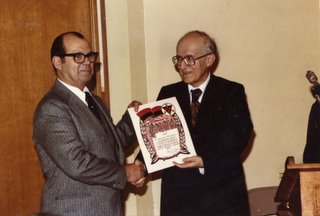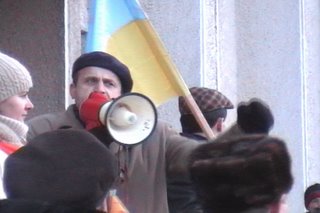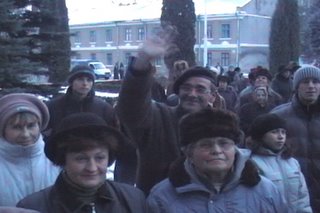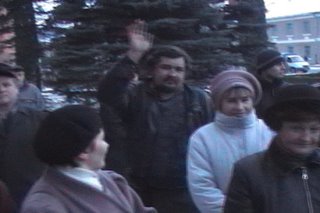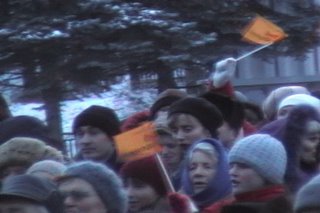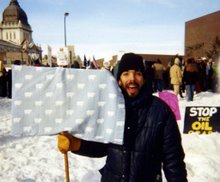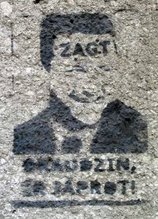This past Saturday, November 26, was the official day of commemoration of the holodomyr, about which you can read here for more details. In short, the term "holodomyr" is what Ukrainians use to refer to the 1933 Stalinist Terror-Famine in Ukraine, the North Caucasus, and Central Asia during which 5-7 million were killed in Ukraine and 1-2 million were killed in the other regions. My maternal grandmother was a little girl as the famine raged in, and many people dropped dead on the streets and paths of, her khutor not far from the city of Poltava (a hutor is a settlement smaller than a village; a hamlet).Below is a photo of the "monument" to those who died in 1933 that now stands in Kyiv. It is beautiful, but I also find it rather disappointing.
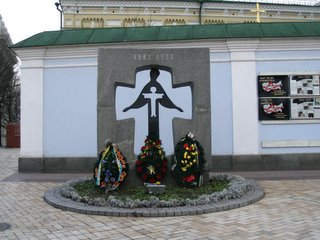
Why is it so small in size? [Note: Monuments and memorials in the former Soviet Union tend to be rather grandiose; there is a reason for why this one is an exception.] Why is it located in such a discreet, inglorious place? That is, it is discreetly tucked away to the side of the St. Michael's Cathedral complex, on a busy plaza with other monuments around, and a lot of business going on. It is not a solemn locale, and the area does not force upon the viewer of this memorial a mood of shock, terror, terrible awe, rage, nor sadness. It is too busy. Too many people getting married on the square before it; too many people rushing about from one cathedral to the next, or quickly heading from one or both of the nearby Cathedrals down Desjatyna St. to Andrijivskyj Uzviz, etc.
7 million people were killed during this event. The Ukrainian-speaking countryside of central and eastern Ukraine was turned into a partially Ukrainian, partially Russian, and most definitely surzhyk speaking area, in large part due to this event. This was an event of enormous cost to Ukrainian culture. Something that shows the true magnitude of what was lost in 1933 should be in place. This is NOT it.
The statue itself is beautiful. Really beautiful. I want it reproduced on a much larger scale. Borrowing from the Vietnam Wall, I want a series of walls with 7 million dots or something in the place of the long-forgotten names (it will never be possible to get all the names) at the base of the enlarged version of this beautiful statue. I want an eternal flame. I want a chapel or prayer center, and places to light candle sticks, etc. I want to feel like I am entering a truly solemn and holy place, a place marking how close the nation came to loosing a chunk of its soul. I want to feel safe to cry there. I want to see people go there and cry or be contemplative.
In short, what I want is for Ukraine to become more truly open to its history.
Some words from my baba (from an interview I recorded with her in English with one of my brothers around, who does not know Ukrainian):
“We were called kulaks because we had it, two cows, and we kept the village tractor. It was decided over and over again that we should keep it, tractor, by people in our village. My father was man who knew fix it, and others would come him from other village to ask for help to fixing their tractor. But soldiers came, took everything from us. My mother, she tried to hide some food behind the stove (the large, clay-tiled stoves that function as a radiator for heat) but the soldiers, they just find it, and when they did, they beat my mother. . .jak I cried it! It was just terrible; I was so young, so young, but I remember it, everything. . .”
“We know our neighbor was eating the children. That’s what we thought. So my mother, she used to make us to go to cellar. We'd stay, all day; we only can come out at night, when there was no light in house.”
“The hunger was terrible, I remember how. . .jak we were children. You know, we would cry it and cry, and my mother, she did everything she could. There was soup of mice and rats and leaves, and just of anything. We all survived it, but other families, they just died.”
My maternal grandmother’s khutor was called Chetverylivka, and was not far from city of Poltava. It no longer exists. My grandmother’s maiden name was Chetverylo; her family, and my ancestors from her side, is most likely descendent from those whomever had founded the settlement, which probably was a Cossack settlement.
Just nine years later she would be kidnapped from her khutor and whisked off to Germany, where she initially worked as a slave (what is a “forced laborer” if not a slave?) in a munitions factory making bombs for the German war effort. She was later transferred from Germany to Belgium, where she was at the end of the war, working the land of German colonists in the area who nonetheless had treated her well.
Every step of the way, she had numerous brushes with death. To this day she is devote in her faith because she believes God watched her and protected her in her youth. I would like to take her someday to a real monument commemorating some of the things she suffered.
Holodomyr survivor, Ostarbeiterin, my maternal Baba: I want to tell you in commemoration of this day how much I love you, and how deeply I respect you, especially for the way you have preserved your ability to laugh and to make others laugh against the greatest of odds. You truly understand that life is beautiful. The magic you have in your soul touches everyone who comes into contact with you in the most profound of ways, and you have helped nourish within me that ability to keep sight of the light that will always be my guide. Thank you Baba Omaha (what my siblings, mother, father, and I call her because of where she made her life in the US).
Afterthought a day later: although there are those nutcases who claim that the famine did not even happen, or that it was not as completely devastating for the peasantry of central and eastern Ukraine as the historians of the holodomyr claim it was, most people agree that a famine did take place, and that a lot of people died to devastating effect on Ukraine. What they disagree on is how and why it happened. Nonetheless, whether or not you think that it was
a) a famine that was the accidental result of poor policies that, once it was underway, was taken advantage of as an instrument for the deliberate killing off and pacification of either a people or a class (which of course is another debate, whether the target of the killing really was "the Ukrainian people" as such, or more specifically peasants or an imagined class of peasants), or
b) a deliberately planned terror-famine or genocide from the start, or
c) was merely the result of poor policies that had horrifying consequences which nonetheless were not the result of the Soviet government having had turned the crisis into a deliberate genocide, or
d) was merely as the result of poor weather, etc.,
is not the point still that millions died tragically? Should this tragedy not, whatever one considers its causes to have been, be memorialized in any real or significant manner?
Making every fourth Saturday in November a day of commemoration is a huge step in the right direction.
And another note: I personally do consider it a genocide, or even better put it was linguicide, whether the intention was to kill off much of and to tame a nation, or more narrowly to kill off an imagined class. My grandmother says that she had very infrequently heard Russian before 1933. Officials and soldiers speaking Russian had been to their village, and she remembers not understanding them as a child. She also remembers that the amount of food her family was alloted in the months after the government decided to start feeding people again did not depend only on her parents' work on the newly collectivized land, but also on her and her older siblings' progress in Russian language lessons. She also recalls having a bar of soap stuffed into her mouth for refusing to speak Russian and thus for speaking only in Ukrainian at the school. She was a little girl then, in the heart of the Poltava region, where today many people speak a strong mixture of both Russian and Ukrainian instead of the pure Poltava dialect of Ukrainian that was still widely spoken in my grandmother's time, and which became the foundation for the literary language and the official national version of Ukrainian. 1933 transformed this countryside in the most brutal and unnatural of ways. There was no natural gravitation toward the Russian language; the history of this change is drowned in blood and tears. It was linguicide, if not also cultural genocide.
But Ukrainians should refrain from using the term "holocaust;" to my mind that term is best left in reference to what happened to the Jews of Europe. They deserve their own term. The holodomyr, although just as sinister in its engineering (I am of the a) persuasion as listed above) and massive and terrible, it did not kill off almost the entire population of Ukrainians as did the holocaust nearly killed off all the Jews of Europe.
Call them both genocides to acknowledge their similarities, but give them two different, specific names to summarize the specific differences, of which there are many. . .





